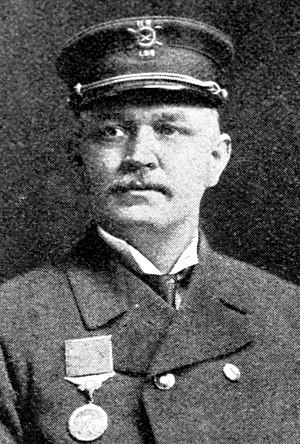Winslow W. Griesser
Winslow W. Griesser was a station keeper in the United States Lifesaving Service, one of the agencies that were merged to form the United States Coast Guard.[1][2][3] In 2016 the Coast Guard honored him by naming one of its new Sentinel class cutters after him.
Keeper
Keepers were fulltime employees, who slept in quarters above the boathouse that formed the core of their stations. Their boat crews were not full-time employees. The station keepers job included recruiting and training local men capable of manning their boats, when needed. The boats were light, and were mounted on light wagons. Their crews would manually tow the wagon to a good launching site, near a distressed vessel. The boats were launched by towing the wagon into the water until the boats buoyancy floated them clear the wagon.
Griesser served at life-saving stations at Fort Niagara, New York, Lorain, Ohio, Marblehead, Ohio and Buffalo, New York.[1]
On November 21, 1900, when commanding the Buffalo life-saving station, Griesser distinguished himself by heroically swimming out to rescue a stranded mariner, in the teeth of a gale.[1][3] Griesser and his crew tried to launch their boat when a scow came loose in the gale-force winds. When his boat was damaged, when being launched, Griesser decided to swim out to the sole remaining survivor of the scow, who was clinging to an offshore pylon. The first attempt by Griesser and one of his crewmen, to swim out to the stranded man, towing a rescue line failed, when the large waves tossed them back on shore, injuring his companion. Griesser then attempted to rescue the man without assistance.
When he got close enough to throw the rescue line to the stranded man, he was too weak to secure himself, and the line fouled the pylon.[1][3] Greisser was able to get close enough to free the stranded man, and secure the rescue rope to him, allowing him to be successfully hauled to safety. Griesser was so exhausted that he collapsed, once he got to shore.
Griesser was award a gold lifesaving medal.[1][3]
Legacy
In 2010 Charles "Skip" W. Bowen, who was then the Master Chief Petty Officer of the Coast Guard, worked to have the cutters in the new sentinel class named after enlisted rank individuals who served heroically in the Coast Guard, or one of its precursor services.[4][5] The USCGC Winslow W. Griesser, commissioned on March 11, 2016, is the sixteenth cutter in the class, and fourth vessel in its cohort of six to be stationed in San Juan, Puerto Rico.[6][2][7][8][9]
Several of Griesser's sons and grandsons enlisted in the Coast Guard.[1][3]
References
- ↑ 1.0 1.1 1.2 1.3 1.4 1.5 Jean Bonchak. Coast Guard Cutter commissioned after man with Northeast Ohio ties, News Herald, 2016-04-05. Retrieved on 2016-04-11. “Griesser’s Coast Guard career carried him to Fort Niagra, Lorain, Marblehead and Buffalo, N.Y. where his courageous rescue took place.”
- ↑ 2.0 2.1 Stephanie Young. Coast Guard Heroes, United States Coast Guard, 2010-10-27. Retrieved on 2012-04-20.
- ↑ 3.0 3.1 3.2 3.3 3.4 Christopher Havern. Coast Guard Heroes: Winslow W. Griesser, US Coast Guard, 2014-01-14. Retrieved on 2016-03-02. “Once on the beach Griesser saw that a man from one of the scows was hanging onto a pile. As use of a boat was impracticable, Griesser decided to swim out with a line accompanied by a surfman.”
- ↑ Susan Schept. Enlisted heroes honored, United States Coast Guard, 2010-03-22. Retrieved on 2013-02-01. “After the passing of several well-known Coast Guard heroes last year, Master Chief Petty Officer of the Coast Guard Charles “Skip” Bowen mentioned in his blog that the Coast Guard does not do enough to honor its fallen heroes.”
- ↑ U.S. Coast Guard announces name for first Sentinel-class cutter, 2010-03-22. Retrieved on 2013-02-01. “Previously designated to be named the Coast Guard Cutter Sentinel, the cutter Bernard C. Webber will be the first of the service’s new 153-foot patrol cutters. Coast Guard Commandant Admiral Thad Allen approved the change of the cutter’s name to allow this class of vessels to be named after outstanding enlisted members who demonstrated exceptional heroism in the line of duty. This will be the first class of cutters to be named exclusively for enlisted members of the Coast Guard and its predecessor services.”
- ↑ Bollinger delivers FRC Winslow Griesser, Marine Log, 2015-12-23. Retrieved on 2016-03-02. “Winslow W. Griesser, Keeper of the Buffalo Life-Saving Station in New York, was awarded the Gold Lifesaving Medal on February 23, 1901 for his heroic actions during a dramatic rescue on November 21, 1900.”
- ↑ Coast Guard accepts delivery of fast response cutter Winslow Griesser, Coast Guard News, 2015-12-28. Retrieved on 2016-03-02. “Fourteen FRCs are in service: six in Miami; six in Key West, Florida; and two in San Juan. The 15th FRC, the Joseph Napier, was delivered in October and is scheduled for commissioning in San Juan in January 2016.”
- ↑ Bollinger Delivers The CGC Winslow Griesser, The 16th Fast Response Cutter To The USCG - Wednesday, December 23, 2015, Bollinger shipyards, 2015-12-23. Retrieved on 2016-03-02. “The 154 foot patrol craft WINSLOW GRIESSER is the 16th vessel in the Coast Guard's Sentinel-class FRC program.”
